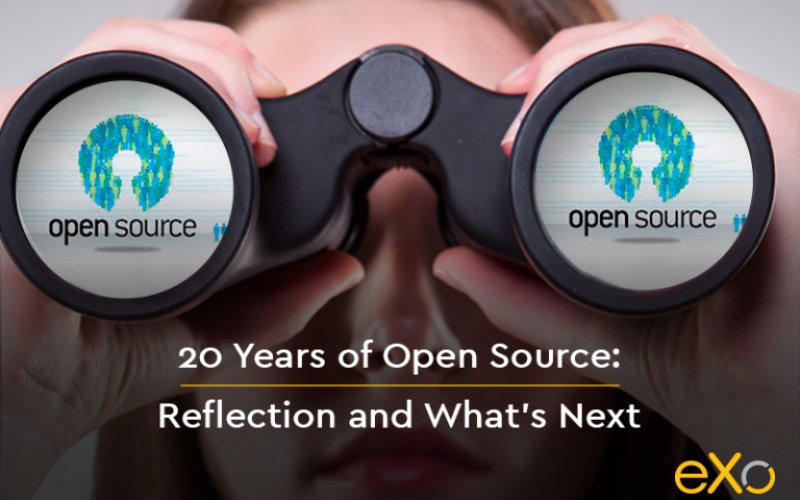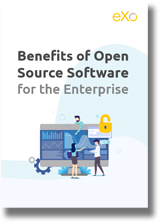- Walid Hamrouni
- January 16, 2019
20 Years of Open Source: Reflection and What’s Next
Open source just celebrated a major milestone and reached 20 years. As the open source community continues to grow, let’s reflect on the past years of how a once-controversial idea made it big, and see where it might go ahead.
Back in 1998, browser-maker Netscape took the unprecedented decision to release its source code, marking one of the world’s first ventures into open source.

Content
Not long after, nanotechnologist Christine Petersen coined the term “open source” while commenting on the news in California referring to this new concept.
Now while the name was new, the principle behind it wasn’t. In 1983, the GNU project set up by Richard Stallman was a fierce advocator for “free” software: freely distributed, open to be used by anyone, as well as distributed and modified, which is ideologically different from open source but with some similarities.
In the early ’90s, Linus Torvald had released his first prototypes of Linux – an open source operating system.
By the late ’90s, mainstream recognition of Linux and Netscape’s release of its source code increased participation and interest of open sharing software.
It took some time, but after 20 years it is now difficult to find anyone from the tech industry that hasn’t used or at least heard of open source.
Open source became even more common, as the world’s biggest organizations now use this technology in some capacity.
According to a 2015 survey, by Black Duck Software and North Bridge, 78% of companies surveyed are using open source software.
In addition, according to a 2016 survey, 90% of companies surveyed say that open source technologies improve efficiency, interoperability, and innovation.
As you may know, open source had overcome many hurdles and skepticism around it. While this initiative seems nowadays natural, many thought that open shared software was developers breaking their backs to end up signing the rights away.
Luckily, enough people believed that open source would make its breakthrough and formed shortly in the late 90’s the Open Source Initiative, to finally state the Open Source Definition.
Is open source a viable business model?
In 2004, the success of SugarCRM was one of the first to defeat the skeptics. This customer relationship management system proved that a business built around an open source technology could be sustainable.
As the benefits offered by open source technologies were more and more recognized, its popularity exploded.
Amongst these benefits, we can note cost reduction, the freedom and people power to increment innovation and, transparency in the based code.
With SugarCRM’s success, a large number of companies around the world rapidly adopted the practice of building their business around open source.
Even Microsoft, who’s been one of the most fierce detractors, eventually came around. We can also talk about Red Hat being acquired by IBM for $34 billion in late October 2018, which is the biggest open-source acquisition ever.
In 2003, our own company eXo Platform was born out of a mission to support collaboration in organizations around the globe.
Open source means endless possibilities
One of the biggest selling points of open source and what makes it exciting is collaboration.
At eXo for instance, collaboration is at the core of our product and way of work. It means that not only the internal, but also the external environment should be taken into consideration.
With this model, our software becomes future-proof, as well as able to adapt whenever new needs or developments arise.
With this element of collaboration, possibilities offered by open are endless. With a co-construction approach with our customers, as well as our internal willingness to continuously improve, our platform never ceased to evolve in order to offer the best experience possible.
What’s Next?
We will continue to see open source proliferate, with the rise of smartphones, the Internet of Things (IoT), and wearables have created an explosion of new data sources demanding flexible and affordable solutions for managing it.
In addition, open standards facilitating open communication between them, these technologies will be the areas of focus for open source software.
Open source holds great promise and potential, as it allows for increased collaboration, the distribution of valuable data and access to fundamental resources.
Here’s to another 20 years of innovation thanks to open source!

FREE WHITE PAPER
Benefits of Open Source Software
for the Enterprise
for the Enterprise
Open source
en entreprise
The term open source refers to any solution that has its source code widely accessible to the public for modification and sharing.

FREE WHITE PAPER
Benefits of Open Source Software
for the Enterprise
for the Enterprise
The term open source refers to any solution that has its source code widely accessible to the public for modification and sharing.
- Tags: Open source, Industry trends
Rate this post
I am a product marketing specialist and tech enthusiast. My role at eXo is to support marketing and operational activities for our digital collaboration tool. I will mainly blog about digital transformation, collaboration, open-source tech, and how to navigate through eXo platform.
Reltaed posts
- All
- eXo
- Digital workplace
- Employee engagement
- Open source
- Future of work
- Internal communication
- Collaboration
- News
- intranet
- workplace
- Knowledge management
- Employee experience
- Employee productivity
- onboarding
- Employee recognition
- Change management
- Cartoon
- Digital transformation
- Infographic
- Remote work
- Industry trends
- Product News
- Thought leadership
- Tips & Tricks
- Tutorial
- Uncategorized
Leave a Reply
( Your e-mail address will not be published)
Connexion
0 Comments
Commentaires en ligne
Afficher tous les commentaires


